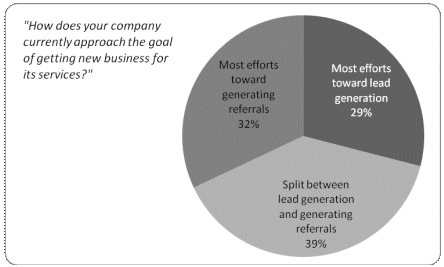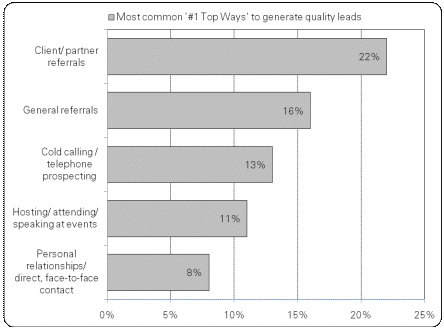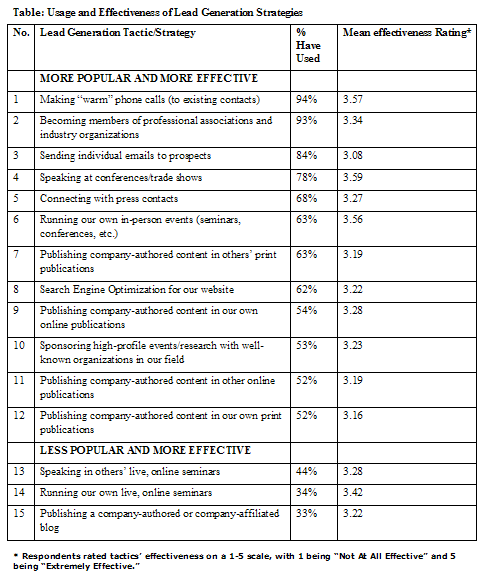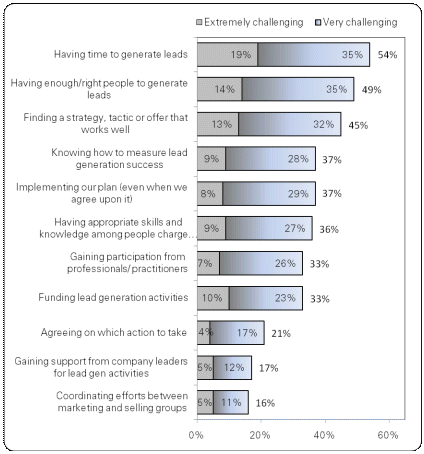“Everyone does the same thing. They might tout their unique systems or processes. But, in reality, when you line up 50 accounting firms with the same specialty, they offer pretty much the same range of services,” says Michael Schultz, Principal of professional services consultancy Wellesley Hills and Publisher of RainToday.com, an online information source for the professional services industry.
Differentiation is difficult because clients typically look for qualities such as reliability, trustworthiness and an ability to do things by the book -- which means firms won’t get far touting themselves as a radical alternative to the norm.
Landing new clients involves a time-consuming lead generation process, in which firms must raise their own profile and start a relationship long before the prospect is ready to hire a new service provider. But within that landscape, which tactics work, which don’t and where are the opportunities for professional services firms to improve their results?
Those were the questions Schultz and his team recently set out to answer with an online survey of 731 members of the professional services industry. We culled key insights, charts and analysis from the 221-page report, 'What’s Working In Lead Generation':
Item #1. Lead Gen’s Importance in the Overall Marketing StrategyChart: How Does Your Company Approach the Goal of Getting New Business?
© 2007. RainToday.com and Wellesley Hills Group LLC
To discover how professional services firms generate new business, Schultz asked where they directed most of their marketing efforts: lead generation or client referrals.
Most respondents said they use a combination of the two, but it’s not many more than the number of businesses that still rely mostly on referrals. This could spell trouble for some professional services marketers.
Referrals are a crucial way to generate new business but may no longer be sufficient as a sole marketing tactic. Referrals tend to be most effective for firms that are known in their marketplace. But when you consider that 70% said they are not very well known by their target audience, a bigger focus on lead generation appears even more important.
Item #2. Top Lead Generation TacticsChart: Most Common ‘#1 Top Ways’ to Generate Quality Leads
© 2007. RainToday.com and Wellesley Hills Group LLC
To generate the chart above, Schultz and his team asked respondents (without providing a list of choices) to volunteer their #1 lead generation tactic. Not surprisingly, referrals came out on top. However, two tactics -- cold calling and appearing at events, conferences and trade shows -- have far-reaching implications:
-> Cold calling -- old-fashioned, unloved, yet effective
One of the report’s most significant insights is that cold calling works despite its bad reputation within the professional services industry. “People have a visceral reaction to cold calling,” Schultz says. “They feel like they’re selling themselves or selling the services of the company, and they don’t want to be like a car salesman trying to close, close, close.”
To be effective, cold calling has to be done right. This means:
o Know details about the prospect. Sounds obvious, right? But in another RainToday report, 'The Professional Services Marketing Benchmark Report: How Clients Buy,' 85% of professional services buyers said firms make critical mistakes, such as not listening to their needs or understanding the industry they’re in.
o Call with the right offer. Cold calls that don’t offer value won’t get you far. So rather than starting with a boilerplate rundown of your company’s strengths and famous clients in an attempt to land a meeting, come prepared with a specific offer -- a new research report your firm has compiled about the prospect’s industry or an invitation to a webinar.
o Integrate cold calls with other marketing. As in the example above, cold calls in and of themselves might not be effective, but they may get a prospect to read a white paper or attend a seminar. That, in turn, might be an effective lead generation tactic. The key with cold calls (or direct mail or email marketing or search marketing) is to integrate it into a broader strategy and use them together to achieve specific goals.
-> Expand scope of events, conferences and trade shows to include more online marketing
Compared to technology and other industries, professional service firms are behind the curve in using online lead generation tactics. Only a third of the firms polled publish their own blogs or host their own online seminars, such as webcasts or webinars. But, as the table below shows, the ones that have adopted online lead generation techniques have found these techniques to be quite effective.

© 2007. RainToday.com and Wellesley Hills Group LLC
Those responses, combined with other insights from the survey, lead Schultz to conclude that online marketing will become increasingly important for professional services firms. In fact, when the survey asked (again, without providing a predetermined set of choices) how firms would spend an extra $100,000 in their marketing budget, the top answer was to build a new website or upgrade their existing one.
As with cold calling, it’s important to integrate marketing efforts: email or search marketing that send users back to the website to download a white paper; cold calls that invite people to a webinar, so you can collect registration data to a gauge a prospect’s interest in a particular area; blog post that invite comments from readers, allowing you to collect names and topics for a follow-up contact.
Item #3. Allocate the Necessary Time and PeopleChart: Lead Generation Challenges Facing Professional Services
© 2007. RainToday.com and Wellesley Hills Group LLC
In the end, the toughest aspect of lead generation for professional services firms isn’t related to picking tactics or developing offers, it’s simply finding the time to do it. The reality is that the professionals who work with clients are also expected to generate the leads.
When asked who’s responsible for generating leads:
- 79% said the company’s leaders, such as CEOs, principals, presidents, etc.
- 53% said professionals, such as consultants, accountants, engineers, etc.
The trouble is that it’s hard to pull top professionals like this away from their client focus and their need to generate billable hours. This means professional services firms need to do more than pay lip service to lead generation. If a firm’s managers are able to reach consensus about which lead generation tactics to employ, then it’s up to them to make sure the plan is implemented.
“If you’re not allocating time to generate leads as if it was a billable product, then as a leader, you’re not supporting your company in its lead generation efforts,” Schultz says.
Useful links related to this articleGet your copy of 'What’s Working In Lead Generation':
http://www.sherpastore.com/Pro-Services-Lead-Generation.html
RainToday.com:
http://www.raintoday.com
Wellesley Hills Group:
http://www.whillsgroup.com













